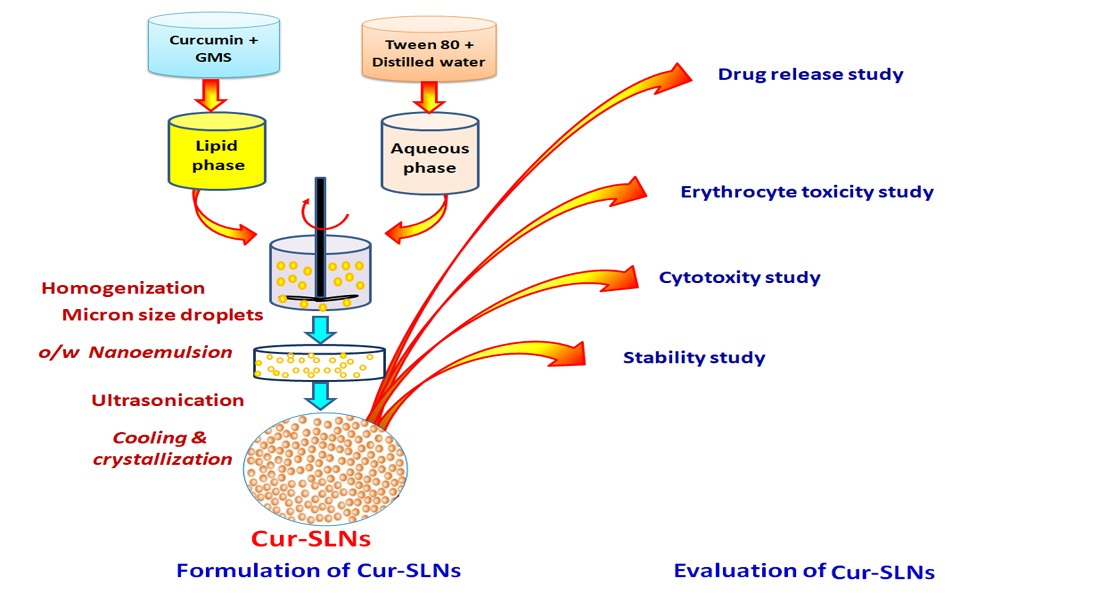Fabrication of Sustained Release Curcumin-Loaded Solid Lipid Nanoparticles (Cur-SLNs) as a Potential Drug Delivery System for the Treatment of Lung Cancer: Optimization of Formulation and In Vitro Biological Evaluation

The goal of current research was to develop a new form of effective drug, curcumin-loaded solid lipid nanoparticles (Cur-SLNs) and test its efficacy in the treatment of lung cancer. Different batches of SLNs were prepared by the emulsification–ultrasonication method. For the optimization of formulation, each batch was evaluated for particle size, polydispersity index (PI), zeta potential (ZP), entrapment efficiency (EE) and drug loading (DL). The formulation components and process parameters largely affected the quality of SLNs. The SLNs obtained with particle size, 114.9 ± 1.36 nm; PI, 0.112 ± 0.005; ZP, −32.3 ± 0.30 mV; EE, 69.74 ± 2.03%, and DL, 0.81 ± 0.04% was designated as an optimized formulation. The formulation was freeze-dried to remove excess water to improve the physical stability.
Freeze-dried Cur-SLNs showed 99.32% of drug release and demonstrated a burst effect trailed by sustained release up to 120 h periods. The erythrocyte toxicity study of Cur-SLNs and its components demonstrated moderate hemolytic potential towards red blood cells (RBCs). The cytotoxic potential of the formulation and plain curcumin was estimated using 3-(4,5-dimethylthiazol-2-yl)-2,5-diphenyltetrazolium bromide (MTT) assay against A549 cell line. After 48 h of incubation, Cur-SLNs demonstrated more cytotoxicity (IC50 = 26.12 ± 1.24 µM) than plain curcumin (IC50 = 35.12 ± 2.33 µM). Moreover, the cellular uptake of curcumin was found to be significantly higher from Cur-SLNs (682.08 ± 6.33 ng/µg) compared to plain curcumin (162.4 ± 4.2 ng/µg).
Additionally, the optimized formulation was found to be stable over the period of 90 days of storage. Hence, curcumin-loaded SLNs can be prepared using the proposed cost effective method, and can be utilized as an effective drug delivery system for the treatment of lung cancer, provided in vivo studies warrant a similar outcome.
Download the full article as PDF here Fabrication of Sustained Release Curcumin-Loaded Solid Lipid Nanoparticles (Cur-SLNs) as a Potential Drug Delivery System for the Treatment of Lung Cancer: Optimization of Formulation and In Vitro Biological Evaluation
or read it here
Materials
Curcumin was generously supplied by Loba chemicals, Banglore, India. Tween 80 was procured from Merck India Ltd. Glyceryl monostearate (GSM) was kindly delivered by Gattefosse, France. Trehalose was delivered as a gift sample from Sigma Aldrich, Inc., St. Louis, MI, USA. Dialysis membrane (MWCO: 1200 g/mole) was purchased from HiMedia, Mumbai, India. Human lung cancer cell line (A549) was procured from the American Culture Collection. The rest of the chemicals used were of analytical reagent grade.
Rahman, M.A.; Ali, A.; Rahamathulla, M.; Salam, S.; Hani, U.; Wahab, S.; Warsi, M.H.; Yusuf, M.; Ali, A.; Mittal, V.; Harwansh, R.K. Fabrication of Sustained Release Curcumin-Loaded Solid Lipid Nanoparticles (Cur-SLNs) as a Potential Drug Delivery System for the Treatment of Lung Cancer: Optimization of Formulation and In Vitro Biological Evaluation. Polymers 2023, 15, 542. https://doi.org/10.3390/polym15030542

